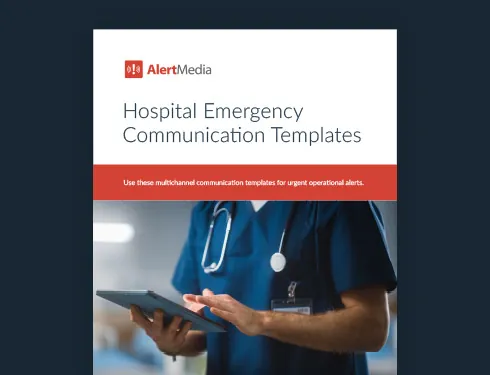
How to Prepare for a Joint Commission Survey: Tips to Stay Ahead
Every 36 months, The Joint Commission comes knocking. But an unannounced accreditation survey doesn’t have to mean a last-minute scramble. Prepare your hospital well in advance so you aren’t caught off guard.

Healthcare facilities are held to a high standard regarding quality-of-care guidelines and regulations—and for a good reason. When life safety is at stake, cutting corners isn’t an option. However, these facilities have many moving parts, and patients often encounter different care providers and processes.
To ensure these processes work according to plan and patient safety remains the priority, hospitals and other facilities are accredited by The Joint Commission. This regulatory nonprofit sets standards and evaluates healthcare organizations in the United States.
To receive accreditation, hospitals get an onsite visit from The Joint Commission every three years. This process, known as a survey, can be an intimidating time—but just like with any other regulatory visit, the trick is planning ahead. This article breaks down what to expect and how to prepare for a Joint Commission survey.
Download Our Hospital Emergency Communication Templates
Who needs a Joint Commission survey?
While not required, earning accreditation from a Joint Commission survey establishes your facility as a high-quality institution with strong patient care. Hospitals tend to be the primary facilities working with The Joint Commission, but any of the following organizations can benefit from going through the accreditation program:
- Ambulatory healthcare facilities
- Behavioral healthcare facilities
- Nursing care centers
- Critical access hospitals
- Home care organizations
- Disease-specific healthcare facilities
- Other medical centers
What to Expect From a Joint Commission Survey
Joint Commission surveys are extensive affairs where the surveyors assess the quality of care your facility provides and whether your hospital meets the accreditation standards. Luckily, Joint Commission resources and documents cover what to expect. You can find a full breakdown of the Joint Commission survey schedule on their website, which goes step by step through the entire survey and the E-dition (online manual) with information about accreditation requirements and standards your facility will be expected to meet.
One of the most important things to know about Joint Commission accreditation surveys is that they are unannounced. Occasionally, surveyors will give organizations a heads-up that the survey is happening, but usually, the surveyors will simply show up the morning of survey day. But while the actual survey day is unknown, that doesn’t mean you can’t start getting your facility prepared now. Hospital accreditation should be a continuous process rather than a once-every-three-year experience you forget about until it happens again.
What does a Joint Commission survey process look like?
Once the surveyors arrive, you’ll have some time (usually 30–60 minutes) to prepare for the actual onsite survey—gathering all your required documentation and informing your staff of the survey and what is expected of them. There will also be a series of briefings and conferences that cover safety procedures and general orientation and introduction.
Then comes the individual patient tracer, where surveyors follow a patient through every step in their care process, assessing the quality of patient care, checking for safety issues or medical errors, determining healthcare professionals’ competency, and doing a comprehensive review of health outcomes. The trace will involve looking through medical records and interviewing care providers and any staff involved in the care of that patient.
After the individual tracer, there will be a series of different meetings, observations, interviews, reviews, and tracers covering things such as:
- Competence assessment
- Medical staff credentialing & privileging
- Emergency management
- System tracer—data management, infection control, and medication management
Each of these activities will take between 30 and 90 minutes and will be scheduled based on the organization’s specific needs and the surveyors’ discretion. Surveyors may also add several optional activities if they deem them necessary.
The survey will end with some time to prepare a report of the survey findings, followed by an exit briefing with the CEO and an exit conference with the organization. From there, it’s just a matter of waiting for the official verdict on your accreditation and any necessary quality improvements the surveyors identified. Then, in another 36 months, the whole process starts again.
What do I need to have for a Joint Commission survey?
A significant part of the survey will be spent reviewing paperwork to ensure that you are meeting certain requirements regarding staffing, performance improvement, infection prevention, the Environment of Care, emergency management, and standards compliance.
You can find the complete list of required documentation, but here are some examples of what you’ll need to have ready:
- Hospital license
- CLIA certificates
- Organization chart
- Organ, tissue, and eye procurement policies
- Performance improvement data from the past 12 months
- Patient flow documentation
- Analysis from a high-risk process
- Environment of Care data
- Emergency management documentation
- Infection control surveillance data from the past 12 months
- Available regulatory reports (CMS, state)
- Medication management policy
- And more
You’ll also want a list of staff members who will assist in the survey. These staff members will guide the Joint Commission surveyors through the facility for the duration and provide any assistance needed.

What happens after a Joint Commission survey?
Once the surveyors finish the exit conference and wave goodbye, it’s time to wait for their verdict. Receiving the results of your survey can take from two weeks to two months. When surveyors reach a decision, you will receive one of the following accreditation levels:
- Limited Temporary Accreditation
- Accreditation
- Accreditation with Follow-up Survey
- Preliminary Denial of Accreditation
- Denial of Accreditation
Your next 36 months will look a little different depending on which accreditation level you receive. You may receive requirements for improvement (RFIs)—specific things the surveyors found that need to be resolved—that you have 60 days to fix. They might also require additional follow-up via another survey.
Regardless of the official decision, there will be longer-term tasks to keep up with your accreditation. Remember, this isn’t a one-and-done process. The Joint Commission requires consistent documentation to stay compliant, so the accreditation process continues even after the survey. It’s also important to keep up with any new performance standards between surveys so you aren’t caught off guard.
What happens if a hospital fails a Joint Commission survey?
If you receive a preliminary denial of accreditation, it means your hospital had one of more of the following, according to The Joint Commission website:
- “An immediate threat to health or safety to patients or the public”
- “Submission of falsified documents or misrepresented information”
- “Lack of a required license or similar issue at the time of survey”
- “Failure to resolve the requirements of an Accreditation with Follow-up Survey status”
- “Significant noncompliance with Joint Commission standards”
But that doesn’t mean accreditation is off the table for you. You can appeal the accreditation decision, or you can work on improvements to your hospital’s procedures, documentation, and safety, and you can reapply.
Tips for Joint Commission Survey Preparation
It might seem impossible to prepare for an unannounced survey from a regulatory agency, but it’s not. Your hospital should prepare for the next survey even as one wraps up. Joint Commission standards are published in the E-dition and updated regularly so that you can stay on top of them. You can prepare your facility and staff for the actual survey event by following these Joint Commission survey tips.
1. Make sure all employees are aligned on goals
Since your survey involves all your staff, ensure everyone knows what they should do during the event. Your healthcare providers need to know all the standards relevant to their positions. Keep people up to date and focused on consistent quality care through regular safety moments or meetings and clear communication daily.
2. Establish communication plans for before, during, and after the survey
Clear communication during a joint commission survey will help you stay organized and move efficiently through the process, and it will help your staff feel prepared to do their best. So, build your hospital’s communication plan in advance. Create notification templates for the event and test them, such as alerts to the internal survey team when TJC surveyors arrive. Run drills so your staff knows what the message will look like and how to respond. Rapid notifications can alert all staff of the event at once to maximize the brief preparation window.
Here are a few examples of Joint Commission survey notifications you can templatize:
Facility Alert: The Joint Commission surveyors have arrived at [HOSPITAL NAME]. Prepare your department for survey as soon as possible.
Facility Alert: The Joint Commission surveyors have departed from [HOSPITAL NAME]. All survey activities are now complete.
3. Go through previous survey notes
Look at your past survey performance and ensure you have maintained whatever required improvements you made. You’ll also want to double-check that standards haven’t changed since then.
4. Check documentation
Since record management is a big part of your survey, start tracking and organizing things as soon as possible. You don’t want to be scrambling for a lost file or trying to come up with reporting data at the last minute. You can create a documentation checklist to run through once a quarter or so to ensure everything is up-to-date and accurate.
5. Assign your survey team
You may not know who is going to be on site when the survey starts, but you can create different survey team shifts as you get closer to your general survey time frames. Pick staff members who are friendly, helpful, and know the organization so they can be the most supportive to the surveyors.
6. Conduct a mock survey
Doing a trial run is a great way to show your staff, new and tenured, what the survey is like. Three years can feel like a long time in fast-paced hospital environments, so employees may forget critical steps. Having a test run of the process will help things run much smoother on the actual day. This can be done either as a full-scale drill, or a tabletop exercise.
What Joint Commission Standards Mean for Your Safety Goals
Meeting Joint Commission standards and doing well during the survey is more than just checking the box and becoming accredited. These standards are built around keeping accredited organizations a safe place for patients to receive care and treatment—and a safe place for staff to provide care and treatment in turn. When preparing for your survey, consider how these improvements will directly impact your employees and patients. Establishing these improvements over time is the best way to support your overall safety goals rather than cramming in unsustainable changes at the last minute before your next survey.



